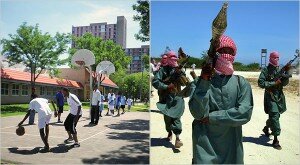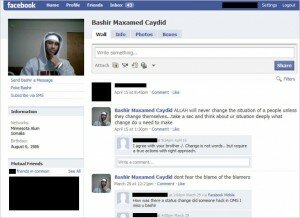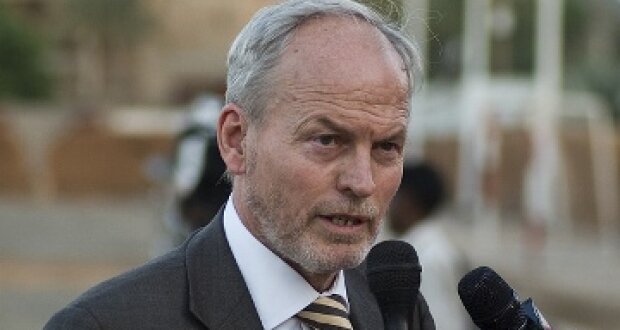 New York Times
New York Times
MINNEAPOLIS — The Carlson School of Management rises from the asphalt like a monument to capitalist ambition. Stock prices race across an electronic ticker near a sleek entrance and the atrium soars skyward, as if lifting the aspirations of its students. The school’s plucky motto is “Nowhere but here.â€
For a group of students who often met at the school, on the University of Minnesota campus, those words seemed especially fitting. They had fled Somalia as small boys, escaping a catastrophic civil war. They came of age as refugees in Minneapolis, embracing basketball and the prom, hip-hop and the Mall of America. By the time they reached college, their dreams seemed within grasp: one planned to become a doctor; another, an entrepreneur.
But last year, in a study room on the first floor of Carlson, the men turned their energies to a different enterprise.
“Why are we sitting around in America, doing nothing for our people?†one of the men, Mohamoud Hassan, a skinny 23-year-old engineering major, pressed his friends.
In November, Mr. Hassan and two other students dropped out of college and left for Somalia, the homeland they barely knew. Word soon spread that they had joined theShabaab, a militant Islamist group aligned with Al Qaedathat is fighting to overthrow the fragile Somali government.
The students are among more than 20 young Americans who are the focus of what may be the most significant domestic terrorism investigation since Sept. 11. One of the men, Shirwa Ahmed, blew himself up in Somalia in October, becoming the first known American suicide bomber. The director of the Federal Bureau of Investigation, Robert M. Mueller, has said Mr. Ahmed was “radicalized in his hometown in Minnesota.â€
An examination by The New York Times, based on interviews with close friends and relatives of the men, law enforcement officials and lawyers, as well as access to live phone calls and Facebook messages between the men and their friends in the United States, reveals how a far-flung jihadist movement found a foothold in America’s heartland.
The men appear to have been motivated by a complex mix of politics and faith, and their communications show how some are trying to recruit other young Americans to their cause.

A screenshot of the Facebook profile of Mohamoud Hassan, one of a group of Minneapolis men who left for Somalia to join in a militant Islamic movement last November. Mr. Hassan went by another name, Bashir Maxamed Caydid, on his Facebook account.
The case represents the largest group of American citizens suspected of joining an extremist movement affiliated with Al Qaeda. Although friends say the men have never thought of carrying out attacks in the United States, F.B.I. officials worry that with their training, ideology and American passports, there is a real danger that they could.
“This case is unlike anything we have encountered,†said Ralph S. Boelter, the special agent in charge of the F.B.I.’s Minneapolis office, which is leading the investigation.
Most of the men are Somali refugees who left the Twin Cities of Minneapolis and St. Paul in two waves, starting in late 2007. While religious devotion may have predisposed them to sympathize with the Islamist cause in Somalia, it took a major geopolitical event — the Ethiopian invasion of their homeland in 2006 — to spur them to join what they saw as a legitimate resistance movement, said friends of the men.
For many of the men, the path to Somalia offered something personal as well — a sense of adventure, purpose and even renewal. In the first wave of Somalis who left were men whose uprooted lives resembled those of immigrants in Europe who have joined the jihad. They faced barriers of race and class, religion and language. Mr. Ahmed, the 26-year-old suicide bomber, struggled at community colleges before dropping out. His friend Zakaria Maruf, 30, fell in with a violent street gang and later stocked shelves at a Wal-Mart.
If failure had shadowed this first group of men, the young Minnesotans who followed them to Somalia were succeeding in America. Mr. Hassan, the engineering student, was a rising star in his college community. Another of the men was a pre-med student who had once set his sights on an internship at the Mayo Clinic. They did not leave the United States for a lack of opportunity, their friends said; if anything, they seemed driven by unfulfilled ambition.
“Now they feel important,†said one friend, who remains in contact with the men and, like others, would only speak anonymously because of the investigation.
The case has forced federal agents and terrorism analysts to rethink some of their most basic assumptions about the vulnerability of Muslim immigrants in the United States to the lure of militant Islam. For years, it seemed that “homegrown†terrorism was largely a problem in European countries like Britain and France, where Muslim immigrants had failed to prosper economically or integrate culturally. By contrast, experts believed that the successful assimilation of foreign-born Muslims in the United States had largely immunized them from the appeal of radical ideologies.
The story of the Twin Cities men does not lend itself to facile categorizations. They make up a minuscule percentage of their Somali-American community, and it is unclear whether their transformation reflects any broader trend. Nor are they especially representative of the wider Muslim immigrant population, which has enjoyed a stable and largely middle-class existence.
Even among the world’s jihadists, the young men from Minneapolis are something of an exception: in their instant messages and cellphone calls, they seem caught between inner-city America and the badlands of Africa, pining for Starbucks one day, extolling the virtues of camel’s milk and Islamic fundamentalism the next.
“Allah will never change the situation of a people unless they change themselves,†Mr. Hassan, the engineering student, wrote in a Facebook message he posted on April 15. “Take a sec and think about your situation deeply. What change do you need to make?â€
Generation of Refugees
Shirwa Ahmed climbed the worn, concrete steps of Roosevelt High School on his first day as a freshman in September 1996.
A slim boy with a watchful gaze, he was one of hundreds of Somali teenagers who had landed at the school in southeastern Minneapolis. Some had never seen a drinking fountain. Others did not know how to hold a pencil, recalled the school’s principal, Bruce Gilman. They carried unspeakable traumas. A number of the students had witnessed their parents being killed.
“It’s almost unimaginable what some of these kids went through,†Mr. Gilman said.
The country they had fled, on the eastern tip of Africa, was embroiled in a civil war that had left it without a functioning government since 1991.
The anarchy reached American televisions two years later, when warlords shot down two Black Hawk helicopters, killing 18 United States soldiers. By then, tens of thousands of Somalis had died and a mass exodus had begun.
A generation of Somalis grew up in the overcrowded refugee camps of northern Kenya, where malaria, scorpion infestations and hunger took their toll. Tales of America sustained them. Clean water was said to flow freely in kitchens, and simple jobs like plucking chickens paid handsomely.
Proof came in the cash sent by a first wave of refugees who had arrived in the United States in the early 1990s. Minneapolis, with its robust social services and steady supply of unskilled jobs, quickly became the capital of their North American diaspora.
When they ended their shifts as cabdrivers or janitors, many Somalis retreated from American life. They had transformed a blighted stretch near the Mississippi River into a Little Mogadishu, commandeering a grim collection of cinderblock buildings known as the Towers — a onetime fictional residence of the heroine of “The Mary Tyler Moore Show.â€
They cut their hair at Somali barber shops, prayed at Somali mosques and organized themselves along the same clan lines that had divided them for decades, calling on tribal elders to settle family disputes and community rifts.
If the adults kept their distance from American culture, their children had little choice but to dive in.
At Roosevelt, Mr. Ahmed was a quick study. He memorized Ice Cube’s lyrics. He practiced for hours on neighborhood basketball courts. He took note of the clothing and vernacular of his African-American classmates, emulating what he could.
His pants sagged, but never too much. He spoke of “homeboys†and used the “n†word, but gave careful regard to the school’s rules. When a classmate’s purse was stolen, it was Mr. Ahmed who dutifully turned in the thief.
Much as he tried, he failed to fit in.
You’re not black, his peers taunted. Go back to Africa.
Somali and African-American students clashed frequently at the school, but Mr. Ahmed seemed ill-suited to the fight. Taciturn by nature, he recoiled at the taunts, his close friend Nicole Hartford said.
“How can they be mad at me for looking like them?†she recalled him saying. “We’re from the same place.â€
Even as Mr. Ahmed met rejection at school, he faced disapproval from relatives, who complained that he was mixing with “ghetto people,†Ms. Hartford recalled. It was a classic conundrum for young Somalis: how to be one thing at school and another at home.
Developments in the homeland, followed obsessively by the adults, held little interest among teenagers. They rolled their eyes at the older men known as “the sitting warriors,†who debated clan politics with such gusto at one Starbucks that the staff bought a decibel meter to ensure that the noise did not rise above legal limits.
Yet young men like Mr. Ahmed remained tethered to Somalia by the remittances they were pressed to send. After school every day, he joined a stream of teenagers headed for the airport, where he pushed passengers in wheelchairs. He sent half of his income to Somalia, to “relatives we don’t even know,†his friend Nimco Ahmed said.
The war had torn families apart, and fathers were in short supply. Somali boys struggled most visibly. The financial strain on families like Mr. Ahmed’s, which was headed by an older sister, proved staggering. Of the estimated 100,000 Somalis in the United States, more than 60 percent live in poverty, according to recent census data.
After graduating from high school in 2000, Mr. Ahmed seemed to flounder, taking community college classes while working odd jobs, friends said. But he had done better than many peers, who turned to crime and gangs like Murda Squad and Rough Tough Somalis.
At the root of the problem was a “crisis of belonging,†said Mohamud Galony, a science tutor who was friends with Mr. Ahmed and is the uncle of another boy who left. Young Somalis had been raised to honor their families’ tribes, yet felt disconnected from them. “They want to belong, but who do they belong to?†said Mr. Galony, 23.
By 2004, Mr. Ahmed had found a new circle of friends. These religious young men, pegged as “born-agains†or “fundis,†set themselves apart by their dress. Their trousers had gone from sagging to short, emulating the Prophet Muhammad, who was said to have kept his clothes from touching the ground.
Perhaps none of Mr. Ahmed’s contemporaries had undergone a transformation like that of Zakaria Maruf.
A short boy prone to fits of rage, Mr. Maruf began running afoul of the law at the age of 14. For a time, he fell in with the Hot Boyz, a violent street gang.
He seemed to crave recognition. Known on the basketball court as Zak, he was a mediocre athlete, but he pushed himself harder than anyone else, recalled his coach, Ahmed Dahir.
Mr. Maruf threw himself into Islam with the same intensity, becoming a fixture at a mosque near the Towers, where he mastered the call to prayer. “He had an ego the size of Minnesota,†one fellow mosque member said. “It was, ‘Look at me.’ â€
Mr. Ahmed and Mr. Maruf were sometimes seen preaching to kids on the street, offering their own lives as examples of reform. Yet they continued to struggle.
Mr. Maruf’s criminal record had foiled his search for a job. When he proposed to a young woman in 2005, her parents scoffed, one friend recalled. They did not want their daughter winding up “on welfare,†they told Mr. Maruf, who worked at a Wal-Mart.
“They think that life is about money and material things, but watch what that will do for them,†Mr. Maruf told the friend one afternoon, sitting slumped at the mosque.
He seemed to be searching for a clean slate. Both he and Mr. Ahmed would find it thousands of miles away.
A Political Awakening
In 2006, an Islamist movement swept through Somalia and seized control, giving the country its first taste of peace in a generation.
The group, known as the Islamic Courts Union, promised to end 15 years of internecine violence by uniting Somalia’s clans under the banner of Islam. Key ports were reopened, and order was restored to the capital, Mogadishu.
In Washington, officials of the Bush administration saw a threat to East African stability. Hard-line factions of the Courts were thought to be sheltering Qaeda operatives and had declared a jihad against neighboring Ethiopia, a predominantly Christian country. In December 2006, Ethiopian troops crossed the border and routed the Islamist forces with intelligence support from the United States, beginning a two-year occupation.
These events triggered a political awakening among young Somalis in Minneapolis. They had long viewed their homeland’s problems as hopelessly clan-based, but the Ethiopian campaign simplified things. Here was an external enemy against which young Somalis could unite.
Spurred by a newfound sense of nationalism, college students distributed T-shirts emblazoned with the Somali flag and held demonstrations during a frigid Minnesota winter.
The protests took on a religious dimension as well. While the United States had defended the Ethiopian invasion as a front in the global war on terrorism, many Somalis saw it as a Christian crusade into a Muslim land. They were outraged at reports of Ethiopian troops raping Somali women, looting mosques and killing civilians.
Read More






